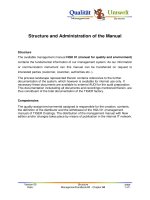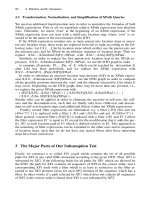Tài liệu Benefits and Challenges of Offshoring doc
Bạn đang xem bản rút gọn của tài liệu. Xem và tải ngay bản đầy đủ của tài liệu tại đây (42.56 KB, 3 trang )
Benefits and Challenges of Offshoring
While there are benefits and risks in incorporating offshore suppliers in a sourcing strategy,
in most cases, companies find that the advantages outweigh the risks.
Benefits
The primary business rationale for offshoring has been to reduce IT operating and
infrastructure costs. The cost savings from offshore outsourcing increase with the
percentage of total development effort outsourced and the percentage of work performed
offshore. They are maximized when the entire development is outsourced and all the work is
performed overseas.
Since the predominant component of IT costs is direct and indirect labor, sizable cost
reductions can be achieved by moving these functions to lower wage rate locations. Based
on recent average wage rates for IT professionals, net savings from offshore outsourcing
generally range between 25 to 40 percent for U.S. and European companies. Cost savings
has been the primary business rationale for offshoring across all industry sectors. The Sand
Hill Group Study found that even technology companies were moving work offshore, driven,
in part, by lower labor costs.
After wage rate differentials, the level of cost savings also depends on the amount of work
that is moved offshore. While an analysis of offshore projects shows that the optimal ratio of
offshore to onshore work ranges between 70:30 to 80:20, some companies only reach a
50:50 split because they desire to have a greater number of people onsite, which reduces
the overall savings.
Offshore outsourcing has been used to achieve a variety of other financial and non-financial
benefits, including:
- Faster time-to-market for new products and services
- Increased focus on core competencies
- Staff augmentation for work load balancing and/or access to skilled IT labor on an as-
needed basis
- Access to skilled IT labor to augment existing (internal) skill sets
- Access to leading technologies
- Ability to have work performed nearly 24/7 by augmenting local activities with development
centers on other continents.
Other reasons for offshore outsourcing include a scaleable business model that can be
ramped up or down very quickly without incurring long-term costs such as unemployment
insurance and employee benefits, and implementing the software development and quality
assurance processes and practices of the offshore suppliers as a way to quickly improve the
customer’s own internal processes.
While labor cost savings have been the primary rationale, additional value can be achieved
over time from enhanced and streamlined business processes. For example, creating a
single shared services environment can generate sizable efficiencies if the current
processes are done in different locations or done by different business units. Business
process reengineering, i.e., removing inefficiencies and bottlenecks and enhancing workflow
using automation and other information technologies, can add additional cost savings as well
as faster cycle times and other business benefits.
Challenges
Before launching an offshore development initiative, senior management needs to
thoroughly understand the challenges to successful offshoring. Major risks and issues
include differences in language, culture, politics, regulations, and work practices—all of
which can disrupt a collaborative customer-supplier relationship. Specifically, some of the
key challenges include:
Internal Organizational Issues
- “Loss of control” of projects and processes
- Increased management attention
- Concerns over retaining intellectual property and other proprietary information
- Concerns over potential legal issues with foreign companies
- Uncertainty about achieving the financial and nonfinancial objectives
- Sensitivity around moving certain types of applications overseas
- Security risks
- Customer preference for suppliers in close physical proximity
- Internal IT departments may not welcome outsourcing due to concerns about job security.
Offshore Market and Supplier Issues
- Formative offshore market
- Dependence on supplier-provided information
- Limited understanding of suppliers’ true reputation and track record
- Socio-cultural barriers and business compatibility
- Infrastructure issues
- Supplier may have little or no experience in the industry or business function/process
- Uncertain political climate.
Project and Process Management Issues
- Communication, language, and cultural issues
- Time zone and holiday schedule issues
- Increased travel costs.
The importance of the risks listed above varies widely from company to company. Some of
the risks presented could be quite costly and damaging to the business, and therefore,
mitigation strategies should be developed before getting underway.
By Dr. Bernard L. Palowitch, Jr., President & CEO of Incoda Corporation.
Source:









